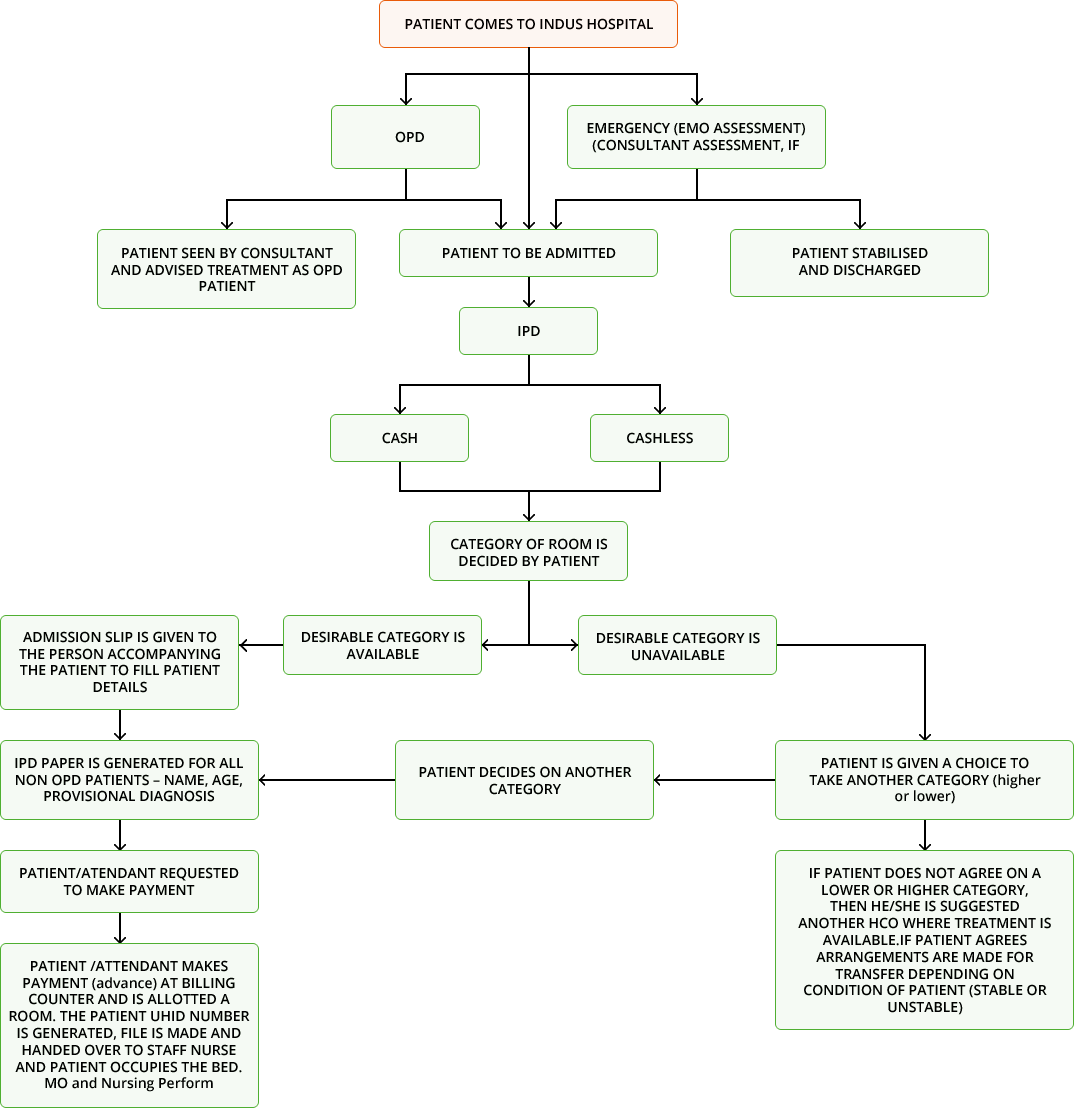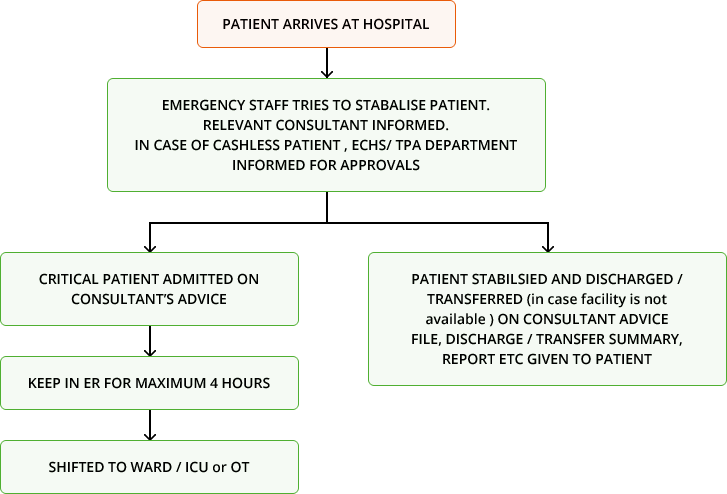Different modes of admission
- Direct Admission from OPD (Appointments /walk-in patients)
- Elective Admission
- Emergency Admission
- Patients with Cashless Services
- Unidentified persons
Admission Process Flow
View Full Size
Admission from OPD
Patient visits the OPD departments of the hospital for consultation, If the patient is coming for the first time, registration is done and UHID generated
- Patient is assessed by the Consultant and decision regarding the need to admit the patient in the IP facility of the hospital is taken by the treating consultant.
- All patients shall be screened with appropriate Clinical, physiological and diagnostic test criteria prior to admission to the hospital. The opinion of the treating physician (Consultant) shall always be considered for patient’s admission in the hospital.
- Patients are admitted only if the required medical care is available in the hospital. In case of any discrepancy in the same, the Operational manager/Director - clinical services is informed by the consultant doctor for clarification.
- The doctor informs the patient and the relatives about the need for admission and indicates the same in the OP case sheet of the patient
- The patient/relatives visit the IPD RECEPTION of the hospital for admission of the patient. (either on the same day or another day depending on urgency for admission)
- The patient/relative provides the OP case sheet of the patient to the admission clerk who checks the same to ensure that IPD admission is advised in writing by the treating consultant of the patient.
- Indus International Hospital, Mohali welcomes all patients. No patient shall be denied admission due to race, color, religion, ancestry, financial class or national origin. Patients shall be admitted to Indus International Hospital by Consultants with admitting privileges. A list of such consultants shall be available with the admission desk.
- Direct referral could be internal or can be referred by an external doctor.
The admission receptionist enquires from the patient about their preferred ward or Room is allotted according or to the patient’s medical condition which is:
- General Ward
- Semi Private Ward
- Private Ward
- ICU
Planned or Elective admission
- A planned admission is an inpatient admission pre-planned in advance of the patient’s presentation for inpatient care.
- All required admission paperwork (including the Authorization letter incase of the TPA, ECHS etc) is submitted either prior to the date upon which the patient is to be admitted or at the time of admission.
- The admission case sheet is printed and the patient is escorted to the appropriate inpatient area.
Registration and Admission Procedure in Emergency
OPD Patients During Non OPD Hours
- During OPD working hours, if a non-critical patient walks into emergency he is directed to go to the concerned OPD after registration at the general OPD registration counter of the hospital,
- whereas during NON OPD hours and holidays all patients walking into the hospital are screened by the EMO in the Emergency, treated and the same is documented. The patient’s registration is done and UHID NO is generated.
- Entry of patient done in emergency register and if converted to IPD patient then enetery also done in IPD admission and discharge registration.
- Following parameters are captured during registration: Name, Age, Sex, Address and time of admission.
- For referred in patients, same is mentioned on the OPD card along with details of the facility from where referred and reason for referral. Referral slip if available is retained in hospital records.
Process Flow For Emergency
View Full Size
POINTS TO FOLLOW
- Patient’s will only be admitted, treated, or transferred once the test results are available.
- Indus Hospital welcomes all patients. No patient shall be denied admission due to race, color, religion, ancestry, financial class or national origin.
- Patients are admitted by Doctors with admitting privileges. A list of such doctors is available with the admitting desk. The Consultant mentions ‘ADMISSION’ on the OPD card if the patient requires Admission
- Acceptance of non-emergency admissions and transfers shall be made contingent upon verification of available resources through admission desk and protocols which govern accepting transfers from outside the hospital.
- All credit patients (Corporate, TPA, CGHS etc.) shall require an authorization letter (in case of planned admission).
- In emergency, a screening for triage of patients will be carried out.
- Admissions are accepted 24 Hours x 7 days, irrespective of any holidays.
- Patients not registered earlier shall be registered and a UHID shall be generated.
- The admitting desk shall enter the data of the patient in the HIS and the ID Band will be placed on patient by nurse in the ward/inpatient area after identification. (blue for normal ad orange for Vulnerable patients)
- For patients seeking elective admissions, screening and/or diagnostic tests for the specific disease process of that patient should be completed prior to the admission. However exceptions are made based on patients condition and other factors.
- Patient needs for preventive, palliative, curative, and rehabilitative services are prioritized Based on the patient’s condition at the time of admission as an inpatient to the organization.
- When patients are considered for admission as an inpatient to the organization, the screening assessment helps staff identify and prioritize the preventive, curative, rehabilitative, and palliative services needed by the patient and select the most appropriate service or unit to meet the patient’s most urgent or priority needs. The same is achieved by routing all admissions through a triaging system which is located near the Accident & Emergency unit entrance. The health professionals manning the triage unit helps prioritize the patient urgent or priority needs and assist them in addressing them.
ADMISSION
- A patient can be kept in the Emergency until 4 hours. In case, the patient needs treatment which requires more than that, then he/she must be admitted in the hospital room/wards/ICU depending upon the requirement
- For the patients requiring admission , Emergency Admission Note is send across to admission desk. Patient / patient family is informed about the registration and admission. Patient details like patient’s name, address, and all other relevant details are collected in the Registration Form. Enquiry is done whether the patient falls in cash/credit category. The patient is admitted under the consultant as per the roster
- Vacancy in the ward is confirmed from the admission counter and then information is given to the concerned department regarding the admission of the patient.
- If the patient needs emergency attention, e.g.: Hypotension, Acute Breathlessness, Acute abdominal pain, emergency intubation, etc then the E.M.O delivers the immediate treatment and the patient is then sent to the respective ward that is allotted.
- Relatives are directed to the admission counter with the note from the E.M.O. for making the I.P.D paper.
- The I.P.D paper is brought to the casualty for stamping the admission note.
- Admission counter prepares the Indoor paper.
- Once the admission paper is ready, it is taken to the concerned ward.
Patients with Cashless Services in IPD
- The consultant authorizes the pre- authorization form with the assistance of the cashless services department.
- This is sent to TPA for approval of the claim.
- Usually the pre-authorization is approved within 24-48 hrs.
- In case of emergency, confirmation is done on phone from the TPA authority and the treatment is started. The estimated cost and stay is mentioned on the pre-authorization form
- The patient gets discharged from the hospital and the cheque from the TPA is received by the hospital within 3-4 months.
- In case the patient is denied authorization, the reason is explained and then the patient can get treatment by paying from his own pocket and can get reimbursement later.
Deposit Collections
- Minimum deposit is collected at the time of admission as per the bed category chosen by the admitting patient. In case of emergency admission, low deposit admission is also allowed after doing the necessary formalities.
Credit Patient /Insured Patient
- Authorization letter from the concerned company is required for the admission under these categories.
- The company profile of the patient is then checked
- Photocopies of Employee ID and / or the health card are then collected and the category or group of the patient as per the company details is checked.
- Availability of the category of bed as per the company’s norms is checked and the confirmation of the kind of bed is given.
The following will be ensured / provided on admission
- Admission orders by Consultant / Physician.
- Completed admission request form either prior to admission or to be provided by the Resident/treating Doctor immediately on admission.
- Allocation of UHID Number and Wristband identifier.
- Allocation of Bed.
- Attendant Briefing checklist.
- HIS generated Admission form which includes Authorization signed by Patient / family for admission and treatment.
- Estimate of Costs for planned packages/Surgeries/procedures.
- In case of Medico legal admissions, a medico legal stamp is placed on all required admission documents.
Unidentified Patients
The Identification of Patients
When a patient is brought to the Emergency Department without any identification and is not able to self- identify, or is unwilling to self-identify the nurse or designate:
- searches the belongings for identification information
- determines the patient is unknown
- pulls the appropriate unidentified packet -male or female
- Registration will be done using identifiers as
- Name- Unknown/ unidentified 1
- UHID will be generated
- Age - Approx(Unknown 1/Uhid/Approx. 30).
Once the patient has been identified - EMO notifies the police of the identification of patient as necessary. If the patient is to be admitted to an inpatient bed and the patient is still unidentified; continue to use the unknown patient IDENTIFIERS.
Registration of Foreign Nationals
As per the guidelines of the Foreigners Regional Registration Office (FRRO) For any Foreign Nationals, Form-C is to be filled and submitted within 24 hours to the Registration Authority (SSP Office in Sector 76) and the Form C has to approved by the Registration Authority and Police verification is done.
All foreigners (including foreigners of Indian origin) visiting India for medical treatment Medical Visa are required to get themselves registered with the Foreigners Regional Registration Officer (FRRO)/Foreigners Registration Officer (FRO) concerned having jurisdiction over the place where the foreigner intends to stay, within 14 days of arrival.
Supporting Documents to be Submitted For Obtaining Service
- Applicant’s Photo.
- Photo Page, Page indicating validity, Page bearing arrival Stamp of Indian Immigration, Visa with endorsement.
- Form C provides the functionality of registration process of Hotel/ Guest House/ Dharmashala /Individual House / University/ Hospital/ Institute/ Others etc. owners for Form-C.
NOTE: Hospital managements need to fill up the foreigner registration form 'C' only when they admit foreign nationals for stay in the hospital during the course of treatment. Hospitals need not fill up the form when only consultation is offered or treatment is administered to a foreign national at the out-patient-department (OPD). As per section 14(6) of Foreign Registration Act, 1939, not filling up the form is violation of visa norms. A penalty can be levied on those who violate the norms.
